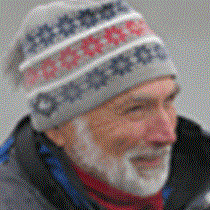We awoke in Chatham Strait, a long waterway cut by a fault line and then scoured out by glaciation. It cuts through the heart of Southeast Alaska and can be thought of as the perfect marine highway for boats traveling anywhere in the northern part of this area. It’s named after the HMS Chatham, a consort vessel used in Captain Vancouver’s exploration of this prominent feature.
Alberto Montaudon, our undersea specialist, did a plankton tow with the help from our younger guests. A long mesh funnel was dragged behind the ship to collect a veritable soup of microorganisms. We took the treasure to the lounge, concentrated it, and placed the brew under the video microscope that was linked to three monitors. One of our guests, Sandy Litvin, has worked with plankton, so gave us an entertaining tour of the tiny marine world that our ship was passing through. Copepods were the most numerous and jerked erratically past sea urchin larvae, crab zoea, unknown worms, and very tiny clams. A predacious arrow worm gobbled down one of the less fortunate creatures. We later dumped our invertebrate guests back into their salty home.
The afternoon was consumed with exploring along a beautifully clear salmon stream lined with old-growth Sitka spruce, western hemlock, and alders. This waterway flows from Lake Eva, and today was filled with hundreds of pink salmon and a few sockeyes. Most of our hikers gazed into a pool with a bottom that was black with salmon. They were waiting for their bodies to change into the superb egg-laying machines they are noted for.
Guests hiking to the lake passed a pond filled with yellow pond lilies and saw a furry mass jump off a log and disappear with a splash. We waited ever so quietly to possibly see what it was. After a few minutes, from across the pond a river otter’s head stuck out from a crack in the rocks. Another smaller head poked above the first and a squirming third tried to get around the side of its mom in the narrow opening. She jerked it down as if it was this family’s troublemaker. After a few minutes of staring out at us and much to our surprise, she swam out into the open with four young in tow. Another hiking group joined us, and not a single person of the 24 made even a tiny rustle as we watched the show. They crawled up on a log, wrestled and played, groomed and laid about, but no activity lasted for more than a few moments. They swam to the other end of the pond then back again out of the water and in again. Most of us never wanted to stop watching them, ever!
Driving lessons for our young travelers happened in late afternoon. Inflatable boats are fast and maneuverable and even faster with youngsters at the helm, so the unfortunate instructor sits low in the stern with his hand loosely on the tiller and throttle. A quick squeeze by the instructor’s hand, and a calamity is avoided. It’s a quick and thrilling ride for everybody.
Dr. Andy Szabo, director of the Alaska Whale Foundation, joined us for dinner and later shared an enlightening program about the complex and fascinating lives of humpback whales in Southeast Alaska.







